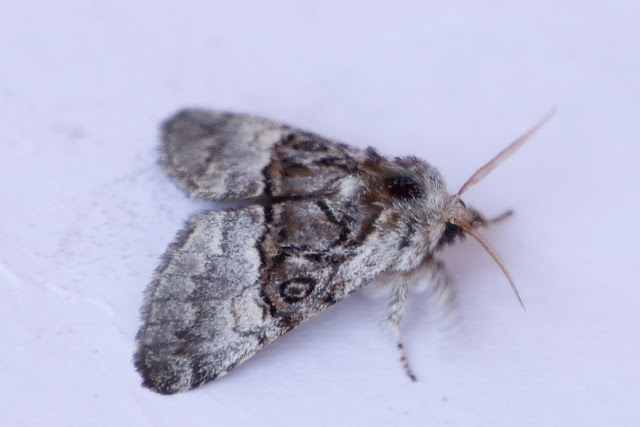Every so often there will be the calls of Long-tailed Tits, and Helen did see young birds on the feeders. The commonest calls belong to those of the Siskins, announcing their arrival, and annoyance if the feeders are not full up. Another regular visitor is the the Bullfinch family, the males vibrant colours standing out in the dark of the trees.
At the bottom of the garden the Ragwort has grown, and this has attracted several Gatekeepers, while the lavender bushes seem alive as the bees continually forage the flower heads.
A few walks through Old Down has not produced anything of real interest, just the continued huge numbers of Meadow Browns, the numbers now being swelled by the equally numerous Gatekeepers. Another butterfly doing well this year appears to be the Red Admiral, they can be seen flying loops around the trees, and chasing away other butterflies.
With it still being quiet I turned once again the the moth trap, the warm weather being ideal conditions and this week saw some more interesting specimens, not least this one. It was interesting for the way that it sat.
This is Endotricha Flammealis, common name rose-flounced tabby, and is a species of snout moth. It likes to nectar on buddleia of which there is a lot around the garden, and is quite common around gardens in southern England. However it is the resting position of this moth that I found fascinating. The front part of the body is raised up on the forelegs, and
the wings held at an angle, with the edges touching the resting surface, as you can just make out from this photograph, almost tiny dragon like!
Next was a moth I haven't seen before, a Yellow-tail. So called because under the white of the wings, the abdomen is yellow.
The female has the yellow tail and is larger than the male. She has yellow hairs at the base of her abdomen which is used to cover the newly laid eggs. Fairly common in the UK, it flies in July and August and can be found in lots of different habitats.
A Scalloped Oak was next, although this managed to escape as I tried to get it out. Fortunately it didn't go too far. It can have a range of colours and markings, but consistently has the two black spots on the wings that help to identify it.
This next moth has turned up on several occasions recently but has always managed to get away and avoid the camera. This time I was more careful to ensure it didn't escape. This is the Ruby Tiger, and the pinkish red abdomen is quite striking.
Its name is more appropriate in southern England, as moving north the body colour becomes a lot greyer. Yet another common moth, it can also be seen flying by day. Here you can see why it was able to escape all those previous times.
There is a species of Elephant moth, that is called a Small Elephant moth, and every year I think I have caught one as the size of the Elephant moths can vary considerably. This one was very small, and I was convinced it had to be a Small Elephant, but when I referred to the books the multi stripe markings on the thorax and single pink stripe on the abdomen were so very obviously belonging to the Elephant Moth. Still they are great to see, and hard to imagine that these beauties are flying around in the dark while we are all asleep.
Finally there were two beautifully marked moths, first the Buff Arches, named for the wings that are a combination of smooth grey and white with orange-brown arches. They have a liking for Bramble which is about in abundance around the hedgerows and woods.
The other was a Nut-tree Tussock, which is on the wing from April to June and July to September in
the south, it is double brooded. The colour of the forewings can vary from grey as is found here to a washed brown. The larvae feed on beech, oak, birch and acer.
So a quiet period at present, hopefully things will pick up later in the month, but we are well and truly in the middle of the the warm dog days of summer at the moment.









No comments:
Post a Comment
Note: only a member of this blog may post a comment.